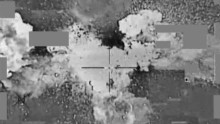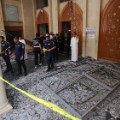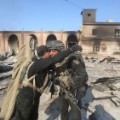Pentagon adopts Israeli tactic in bombing ISIS
Story highlights
- Israeli forces have widely used the so-called knock-on-the-roof operations in Gaza attacks
- Initially the U.S. believed that the knock operation had spared the woman inside, but it hadn't
Washington (CNN)The U.S. has adopted a unique Israeli battlefield tactic in its fight against ISIS: exploding a missile above a building to warn civilians inside that it's about to be bombed.
Israeli forces have widely used the so-called knock-on-the-roof operations in Gaza attacks in recent years to try to get civilians out before they are hit.
The first public revelation of the U.S. using a "knock operation" came Tuesday at a press briefing by Air Force Maj. Gen. Peter E. Gersten, deputy commander for operations and intelligence for the anti-ISIS Operation Inherent Resolve.
Gersten described a strike against an ISIS financial storage center on April 5 in southern Mosul, Iraq. The U.S. had been closely watching the house of an ISIS finance operative, or "finance emir" in the words of Gersten.
"He was the major distributor of funds to Daesh fighters," Gersten said, using another name for ISIS. "We watched him come and go from his house, we watched his supplies, we watched the security that was involved in it. And we also watched occasionally a female and her children in and out of the quarters."
Using reconnaissance aircraft and other intelligence assets to keep watch, the U.S. then began to formulate a plan, Gersten said, to get women, children and other civilians out of the building.
"We went as far as actually to put a Hellfire on top of the building and air-burst it so it wouldn't destroy the building, simply knock on the roof to ensure that she and the children were out of the building," he recounted. "And then we proceeded with our operations."
Gersten acknowledged the Israeli influence, saying, "That's exactly where we took the tactics and technique and procedure from."
Gersten did not indicate that the Israeli military had formally briefed U.S. commanders on how to do knock operations.
But he noted, "We've certainly watched and observed their procedure. As we formulated the way to get the civilians out of the house, this was brought forward from one of our experts."
Gersten said that leaflets were also dropped to warn of a pending attack. In some Israeli operations, phone calls have been made to houses about to be hit as well.
Israel, however, has come under fire from human rights groups for use of the tactic.
"There is no way that firing a missile at a civilian home can constitute an effective 'warning,'" said Philip Luther, Middle East and North Africa Director at Amnesty International, about the Israeli practice in 2014. "Amnesty International has documented cases of civilians killed or injured by such missiles in previous Israeli military operations on the Gaza Strip."
Human rights groups in Gaza agreed.
"The sending of a missile cannot be considered a warning. It is the targeting of civilians with a weapon, regardless of how small, and it is a violation of the Geneva conventions," said Mahmoud Abu Rahma of the Al Mezan Center for Human Rights, also referring to Israel's actions.
"Imagine you are in Gaza and there are airstrikes everywhere, and many families are in the bottom floor of their home," Abu Rahma added. "Families miss the sound of the 'warning' missile because it sounds like just another explosion."
The U.N. weighed in on the Israeli tactic, too, finding in a 2015 report that, "In a number of incidents examined, the concerned persons either did not understand that their house had been the subject of a 'roof-knock,' or the time given for evacuation between the warning and the actual strike was insufficient," pointing to an incident in which several children died after being given just a few minutes to evacuate at a time when most were sleeping.
"'Roof knocks' cannot be considered an effective warning given the confusion they often cause to building residents and the short time allowed to evacuate before the actual strike," the U.N. said.
It is not clear how much time the U.S. provided between the knock operation earlier in April and the actual strike. But initially the U.S. believed that the approach had worked to save the woman whom the U.S. had observed inside the building.
Despite the fact that "the men that were in that building -- multiple men -- literally trampled over her to get out of that building," according to Gersten, she was able to get out herself.
He continued, "We watched her and observed her leaving the building. And she cleared the building, and we began to process the strike."
But then, he said, she ran back in the building.
It was "very difficult for us to watch, and it was within the final seconds of the actual impact," Gersten recalled.
There is video of the entire incident but it's unlikely to be released by the Pentagon because it shows a civilian being killed, according to a defense official.
The U.S. has seen no evidence the finance official has re-emerged and believes he is likely dead. Gersten did not further identify the man or the other ISIS members or civilians killed in the incident.
In his press briefing, Gersten emphasized that ISIS is suffering from morale problems among its fighters, in part due to the shortage of cash after more than a dozen airstrikes against money centers. He noted that the number of foreign fighters coming into Syria and Iraq has now dropped to about 200 a month compared to more than 1,500 a month a year ago, though that may be due to several reasons including morale and stronger border controls.
The U.S. is also putting a long-range artillery system in southern Turkey to conduct more strikes against ISIS targets in Syria, Gersten said.




































































No hay comentarios:
Publicar un comentario